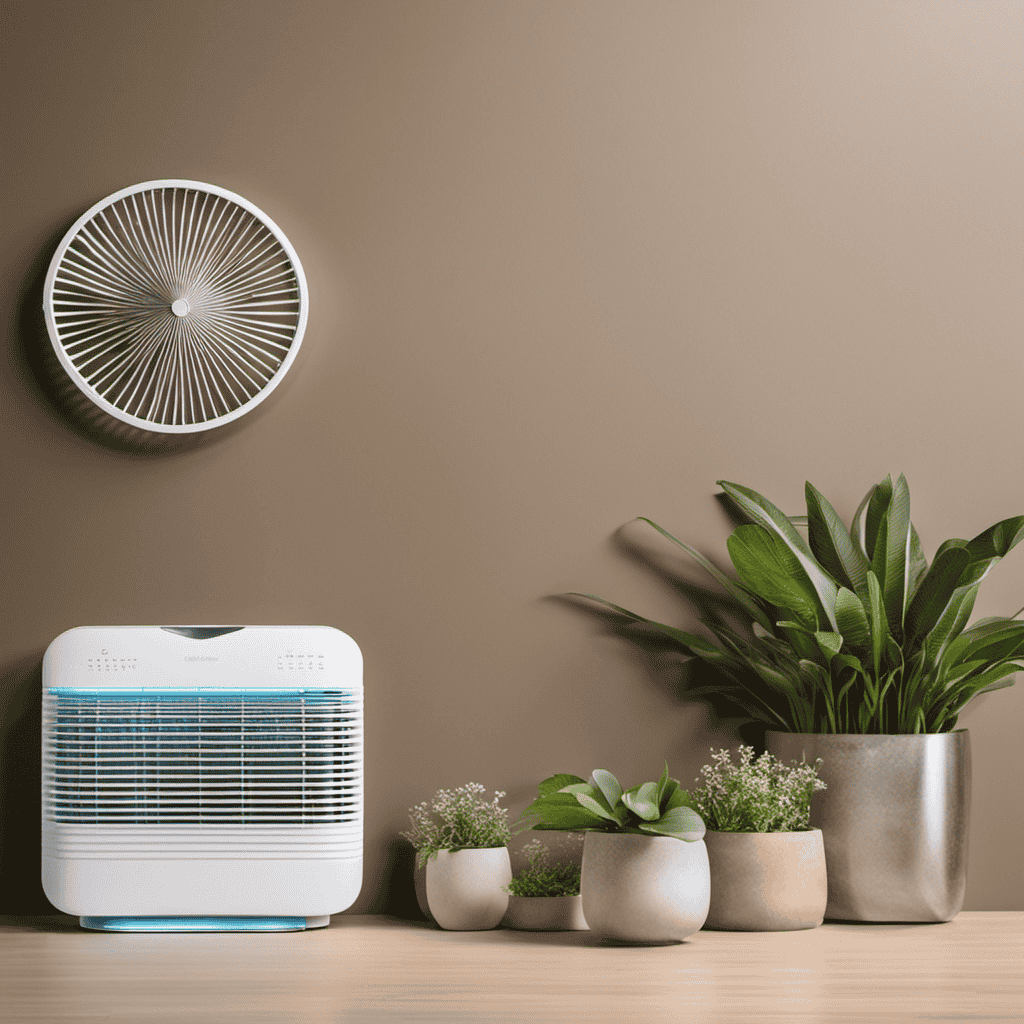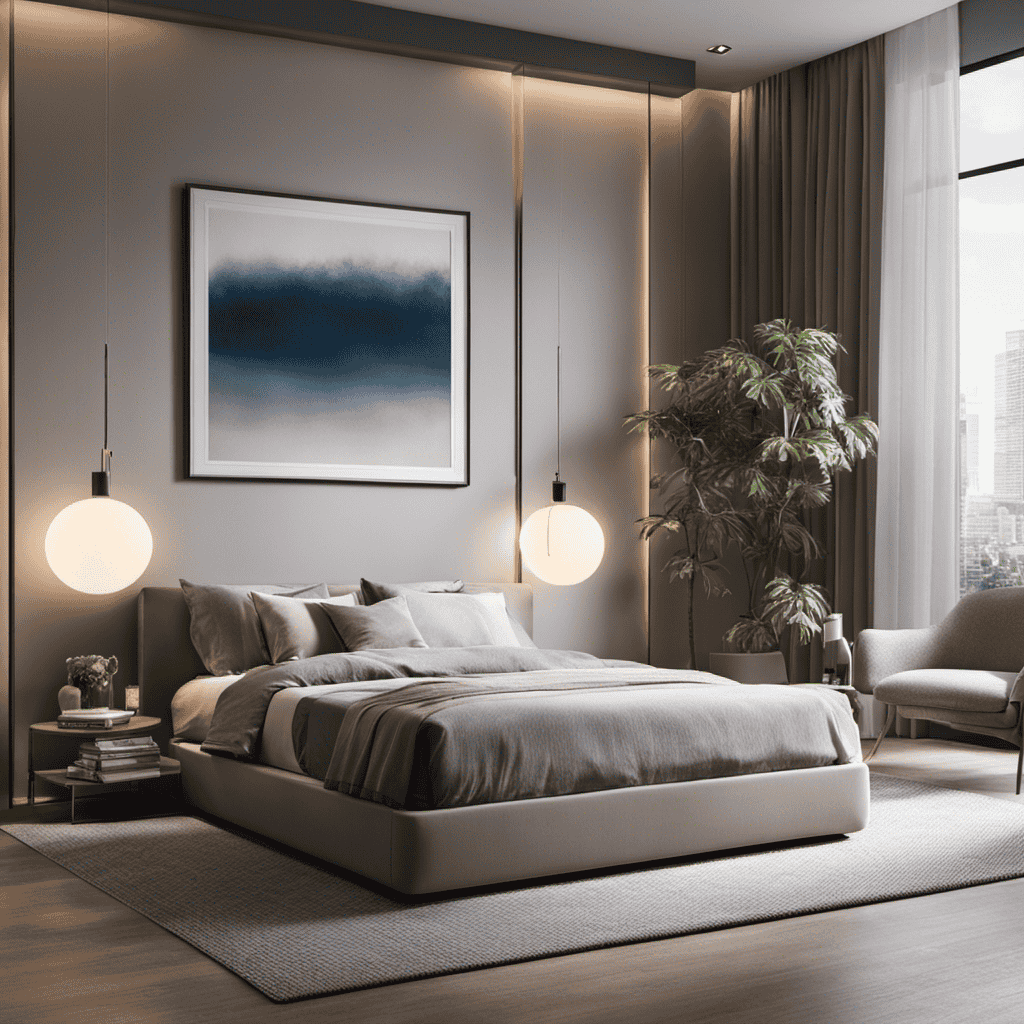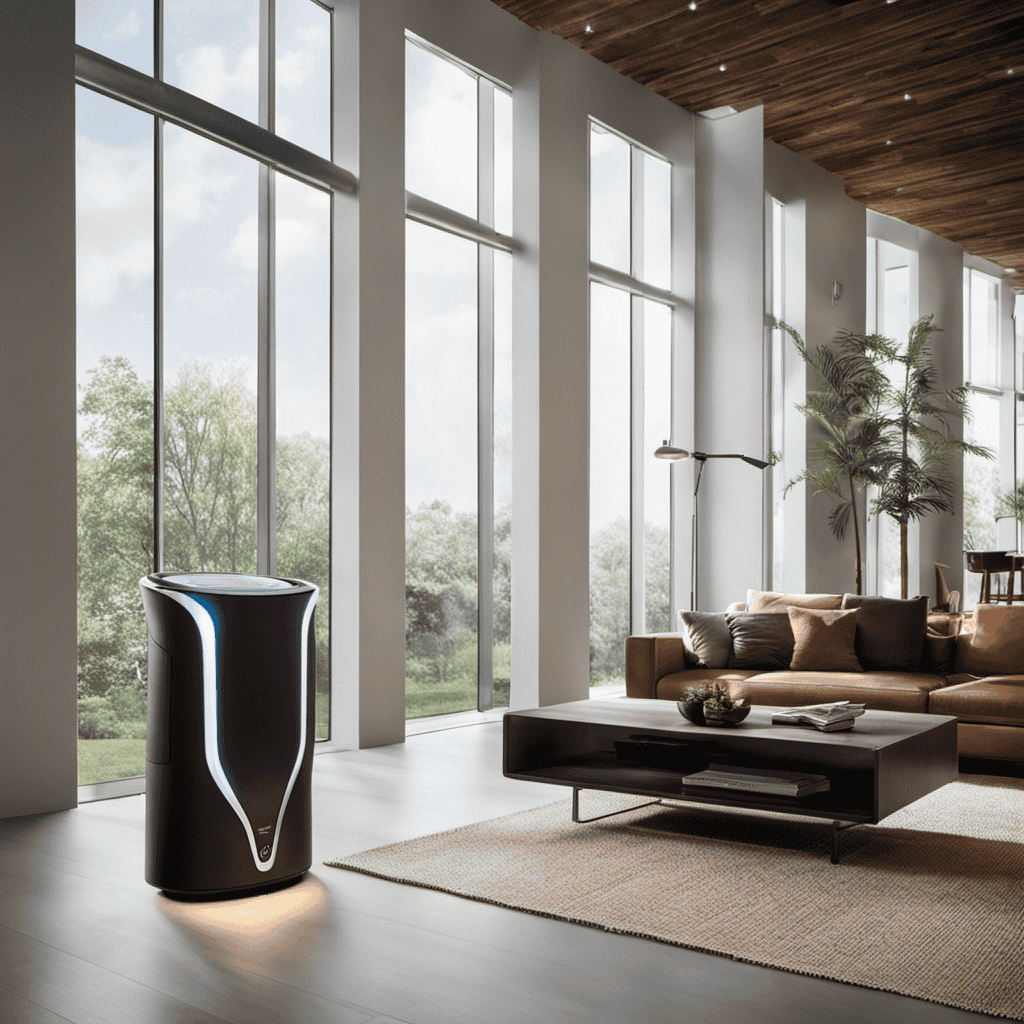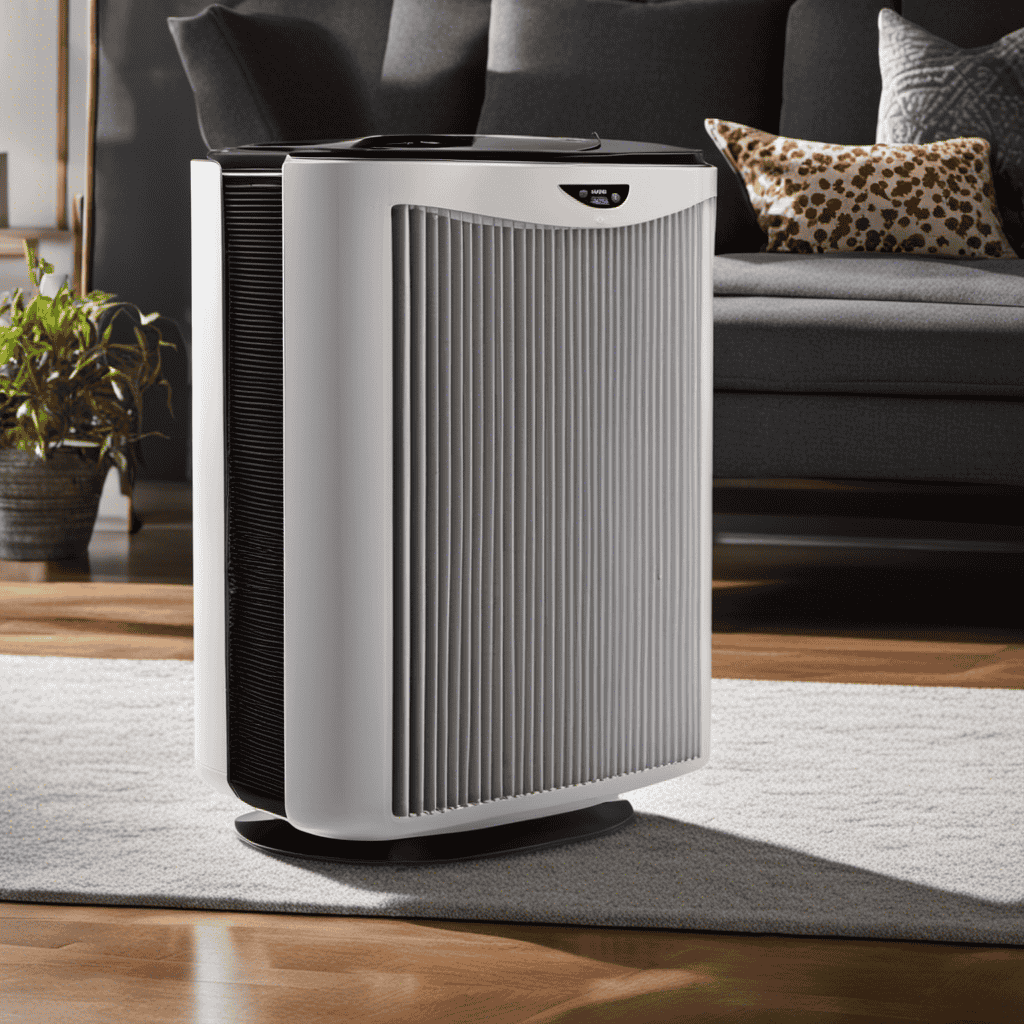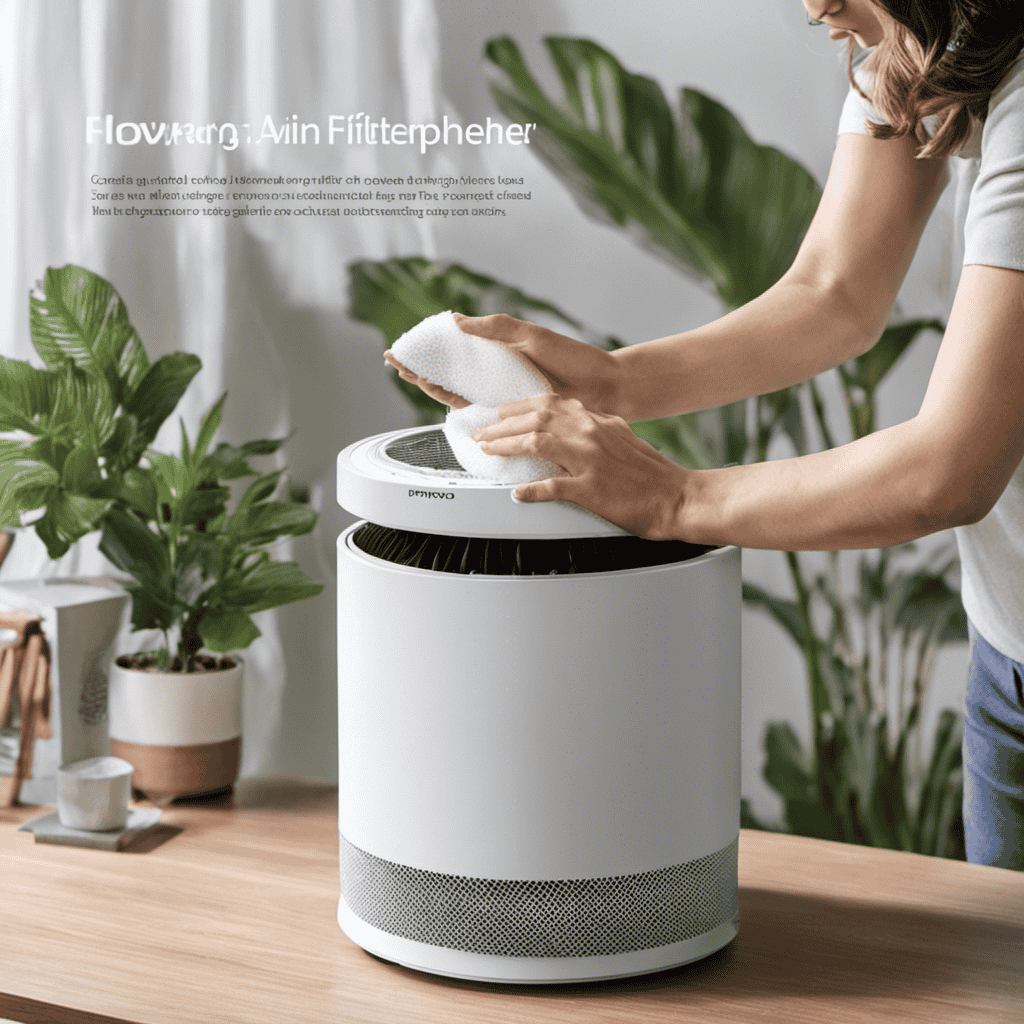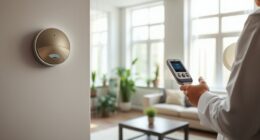As a homeowner, I understand the significance of having clean and healthy air in my home. An essential factor in achieving this is ensuring that my air purifier filter is working effectively.
But have you ever wondered, how long does an air purifier filter actually last?
In this article, we’ll delve into the factors that affect its lifespan, the different types available, and how to know when it’s time for a replacement.
Get ready to breathe easier and discover the secrets to maximizing the life of your air purifier filter.
Key Takeaways
- The lifespan of an air purifier filter is affected by the quality of the surrounding environment and the impact of air pollutants.
- Different types of air purifier filters include HEPA filters, activated carbon filters, pre-filters, UV-C filters, and electrostatic filters.
- The frequency of replacing air purifier filters is recommended every 6 to 12 months, depending on the type of air purifier and the level of air pollution in the environment.
- Signs that indicate the need for a filter change include reduced airflow, musty odor, visible dirt and debris, and the return of allergy symptoms. It is important to follow the manufacturer’s guidelines for specific model recommendations.
Factors That Affect the Lifespan of an Air Purifier Filter
One of the factors that affects the lifespan of an air purifier filter is the quality of the air in the surrounding environment. The filter cleaning techniques and the impact of air pollutants play a significant role in determining how long the filter will last.
Regularly cleaning the filter is essential to maintain its efficiency and prolong its lifespan. Dust, pet dander, pollen, and other airborne particles can accumulate on the filter, clogging it and reducing its effectiveness. By using appropriate cleaning techniques such as vacuuming or washing, these particles can be removed, allowing the filter to function optimally.
Additionally, the level of air pollution in the environment can also impact the filter’s lifespan. High levels of pollutants can cause the filter to become dirty faster, requiring more frequent cleaning or replacement. Therefore, it is important to consider both the cleaning techniques and the quality of the surrounding air when determining the lifespan of an air purifier filter.
Understanding the Different Types of Air Purifier Filters
There are various types of filters used in air purifiers. Each type has its own strengths and weaknesses when it comes to filter efficiency and the types of contaminants it can effectively remove. Here are some key types of air purifier filters:
-
HEPA (High-Efficiency Particulate Air) Filters: These filters are capable of capturing particles as small as 0.3 microns, making them highly effective at removing common allergens like pollen, dust mites, and pet dander.
-
Activated Carbon Filters: These filters are designed to remove odors, gases, and volatile organic compounds (VOCs) from the air. They work by trapping these substances within the porous structure of the carbon.
-
Pre-Filters: These filters are the first line of defense in an air purifier, capturing larger particles like hair, lint, and pet fur. They help prolong the lifespan of the main filter by preventing it from getting clogged too quickly.
-
UV-C Filters: These filters use ultraviolet light to kill bacteria, viruses, and other microorganisms. They are particularly effective in preventing the spread of airborne illnesses.
-
Electrostatic Filters: These filters use an electrostatic charge to attract and trap particles. They can be effective against both large and small particles, but may need regular cleaning to maintain their efficiency.
Understanding the different types of air purifier filters is essential for choosing the right one that suits your specific needs.
Now, let’s explore how often you should replace your air purifier filter.
How Often Should You Replace Your Air Purifier Filter
Understanding the frequency of replacing your air purifier filter is crucial in maintaining clean and healthy indoor air quality. Regular filter maintenance is essential to ensure that your air purifier continues to function effectively. The frequency of replacement depends on various factors such as the type of air purifier, the environment it is used in, and the quality of the air being filtered.
On average, it is recommended to replace your air purifier filter every 6 to 12 months. However, it is important to check the manufacturer’s guidelines for your specific model to determine the exact replacement interval. Regularly replacing the filter not only improves the efficiency of your air purifier but also prevents the build-up of pollutants and allergens in your indoor environment.
In the subsequent section, we will discuss the signs that indicate your air purifier filter needs to be changed, helping you maintain optimal air quality.
Signs That Your Air Purifier Filter Needs to Be Changed
If you notice reduced airflow or a musty odor, it’s time to change your air purifier filter. Regularly cleaning or replacing your filter is crucial to maintain the effectiveness of your air purifier. Here are some key signs that indicate your air purifier filter needs to be changed:
-
Reduced airflow: If you notice that the airflow from your air purifier has decreased significantly, it may be a sign that the filter is clogged and needs to be replaced.
-
Musty odor: A musty or unpleasant odor coming from your air purifier indicates that the filter is no longer able to effectively remove odors and contaminants from the air.
-
Visible dirt and debris: If you can see visible dirt, dust, or debris on your filter, it means that it is saturated and unable to capture additional particles.
-
Allergy symptoms return: If you start experiencing allergy symptoms again, it could be a sign that your air purifier filter is no longer effectively removing allergens from the air.
-
Manufacturer’s recommendation: Lastly, always refer to the manufacturer’s guidelines for recommended filter replacement frequency.
Cleaning and maintaining your air purifier filter is important to ensure optimal performance. HEPA filters, in particular, provide several benefits, including:
-
Efficient filtration: HEPA filters are capable of capturing up to 99.97% of airborne particles, including dust, pollen, pet dander, and mold spores.
-
Allergen reduction: Using HEPA filters can significantly reduce allergens in the air, providing relief for allergy sufferers.
-
Improved air quality: HEPA filters help to remove harmful pollutants from the air, improving overall indoor air quality and promoting a healthier living environment.
-
Odor elimination: HEPA filters can effectively remove odors from the air, making your home smell fresher and cleaner.
-
Longevity: HEPA filters have a longer lifespan compared to other types of filters, reducing the frequency of replacement and saving you money in the long run.
Tips for Extending the Life of Your Air Purifier Filter
When it comes to maintaining and prolonging the life of your air purifier filter, proper maintenance techniques are key. By following these techniques, you can ensure that your filter is functioning at its best and providing you with clean and fresh air.
Additionally, understanding the frequency of replacement for your specific air purifier model is crucial in order to maintain optimal air quality in your home.
Proper Maintenance Techniques
To properly maintain your air purifier, make sure to regularly clean or replace the filter as recommended by the manufacturer. This is crucial for optimal performance and to ensure that the air purifier effectively removes contaminants from the air.
Here are some maintenance techniques and cleaning methods that can help prolong the lifespan of your air purifier:
- Vacuum the pre-filter regularly to remove large particles and debris.
- Clean the main filter using a soft brush or by gently tapping it to dislodge trapped particles.
- Consider using a HEPA filter cleaner or washing the filter if it is washable.
- Replace the filter when it becomes visibly dirty or as recommended by the manufacturer.
- Keep the air purifier in a clean environment and away from sources of dirt and dust.
Frequency of Replacement
To ensure optimal performance, regularly replacing the filter in your air purifier is essential. The frequency of air purifier filter replacement depends on several factors.
One important factor is the type of filter used. Different filters have varying lifespans, with some lasting for a few months and others up to a year.
Another factor is the quality of the air in your environment. If you live in an area with high levels of pollutants, such as dust or pet dander, the filter may need to be replaced more frequently.
Additionally, the usage of the air purifier plays a role in filter lifespan. If the purifier is used continuously, the filter may need to be replaced more often than if it is used intermittently.
Overall, it is recommended to check the manufacturer’s instructions for specific guidelines on filter replacement frequency.
The Importance of Regularly Cleaning Your Air Purifier Filter
When it comes to maintaining your air purifier, two key factors to consider are the lifespan and efficiency of the filter.
The lifespan of a filter will vary depending on the specific model and usage patterns, but generally, it is recommended to replace the filter every 6 to 12 months. Regularly cleaning the filter can significantly extend its lifespan and improve its efficiency, allowing it to effectively remove pollutants from the air in your home.
In addition to prolonging the lifespan of the filter, keeping it clean also offers numerous health benefits. It can reduce the risk of respiratory issues and allergies by removing harmful particles and allergens from the air you breathe.
Filter Lifespan and Efficiency
You’ll want to consider the lifespan and efficiency of the air purifier filter. The filter is a crucial component of an air purifier, as it is responsible for trapping and removing particles from the air.
Here are some tips for cleaning and maintaining your air purifier filter:
- Regularly check the filter for dirt and debris buildup.
- Follow the manufacturer’s instructions for cleaning and replacing the filter.
- Vacuum or wash the filter, depending on the type.
- Allow the filter to dry completely before reinstalling it.
- Keep track of the filter’s shelf life and replace it accordingly.
Health Benefits of Cleaning
Regularly cleaning and maintaining your air purifier can have positive effects on your health. By keeping the air purifier clean, you can ensure that it functions optimally and effectively removes pollutants from the air.
There are several cleaning techniques that you can utilize to maintain your air purifier. Firstly, it is important to regularly clean or replace the filters to prevent the buildup of dust and allergens. Additionally, cleaning the exterior of the air purifier with a damp cloth can remove any dirt or debris that may be present.
By following these cleaning techniques, you can reap the benefits of clean air. Clean air is essential for good health as it reduces the risk of respiratory conditions, allergies, and other health issues caused by indoor air pollution.
Regular cleaning of your air purifier promotes a healthy living environment by ensuring that you breathe in clean and fresh air.
Can You Clean and Reuse Air Purifier Filters
Yes, it’s possible to clean and reuse air purifier filters. Many people assume that once a filter becomes dirty, it needs to be replaced. However, with proper cleaning techniques, filters can be effectively cleaned and reused, saving both money and resources.
Here are some important points to consider:
-
Cleaning effectiveness: Regular cleaning of air purifier filters can help maintain their effectiveness in removing pollutants from the air. By removing trapped particles, the filter can continue to provide clean air for a longer period.
-
Filter reusability: Most air purifier filters are designed to be reusable. Manufacturers often provide instructions on how to clean and maintain the filters, ensuring their longevity and performance.
-
Proper cleaning techniques: It’s important to follow the manufacturer’s instructions when cleaning air purifier filters. This may involve vacuuming, washing, or using compressed air to remove dirt and debris.
-
Frequency of cleaning: The frequency of cleaning will depend on factors such as the air quality in your environment and the type of filter you have. Regular maintenance is key to ensure optimal performance.
-
Replacement considerations: While cleaning can extend the life of air purifier filters, there will eventually come a time when replacement is necessary. It’s important to monitor the filter’s condition and replace it when it becomes excessively dirty or damaged.
How to Properly Replace an Air Purifier Filter
When it comes to air purifiers, it’s important to understand the frequency at which the filters need to be replaced and the proper technique for installation.
Filter replacement frequency will vary depending on factors such as the type of air purifier, the level of air pollution, and the manufacturer’s recommendations.
Proper installation technique ensures that the filter is securely in place and functioning effectively to remove pollutants from the air.
Filter Replacement Frequency
The lifespan of an air purifier filter can vary depending on usage and air quality. It is important to understand the factors that can affect the longevity of the filter in order to prevent filter clogging and maximize filter efficiency. Here are some key points to consider:
-
Regular maintenance: Cleaning or replacing the filter according to the manufacturer’s instructions will help prevent clogging and maintain optimal performance.
-
Air quality: Filters in areas with high levels of pollutants or allergens may need to be replaced more frequently.
-
Usage: If the air purifier is used in a busy household or in a room with constant activity, the filter may need to be replaced more often.
-
Filter type: Different types of filters have different lifespans. HEPA filters, for example, typically last longer than activated carbon filters.
-
Filter monitoring: Some air purifiers have built-in filter replacement indicators that can help track the lifespan of the filter.
By understanding these factors, you can ensure that your air purifier filter lasts as long as possible while maintaining its efficiency.
This leads us to the next section: proper installation technique.
Proper Installation Technique
Improper installation of an air purifier can lead to several risks and diminish its effectiveness in improving indoor air quality. Common installation mistakes can include failing to secure the unit properly, not positioning it in the right location, or neglecting to clean the air intake vents regularly.
If an air purifier is not securely installed, it may vibrate or move during operation, which can result in noise or even damage to the unit. Additionally, placing the air purifier in an incorrect location, such as near a heat source or in a corner, can obstruct airflow and reduce its efficiency.
For optimal performance, it is crucial to carefully follow the manufacturer’s instructions and ensure proper installation of your air purifier.
The Role of Activated Carbon in Air Purifier Filters
Activated carbon plays a crucial role in air purifier filters by effectively trapping and removing harmful gases and odors. This advanced technology utilizes the properties of activated carbon to target and eliminate volatile organic compounds (VOCs) from the air. Here are five key aspects of activated carbon technology in air purifiers:
- Adsorption: Activated carbon has a large surface area that allows it to adsorb and trap molecules of pollutants, including VOCs.
- Chemical reaction: The carbon in the filter reacts with the VOCs, converting them into less harmful substances.
- Longevity: Activated carbon filters can last for several months, depending on the level of air pollution and usage.
- Multiple layers: Air purifiers often incorporate multiple layers of activated carbon to enhance their effectiveness in removing a wide range of pollutants.
- Maintenance: Regularly replacing the activated carbon filters ensures optimal performance and continued removal of VOCs.
With the vital role that activated carbon technology plays in air purifiers, it is important to consider its effectiveness in comparison to other types of filters, such as HEPA filters.
HEPA Filters Vs. Other Types of Air Purifier Filters: a Comparison
When comparing HEPA filters to other types of air purifier filters, there are several key points to consider.
Firstly, the efficiency of HEPA filters is unmatched, as they can remove up to 99.97% of particles as small as 0.3 microns.
Secondly, while HEPA filters may have a higher upfront cost compared to other filters, their long lifespan and effectiveness make them a cost-effective choice in the long run.
Lastly, maintenance requirements for HEPA filters are relatively simple, typically involving regular vacuuming or replacement every 6 to 12 months, depending on usage.
Efficiency of HEPA Filters
HEPA filters are designed to effectively capture small particles in the air. These filters are highly effective in removing allergens, dust, pet dander, and other airborne particles. Here are five key points to understand about HEPA filter effectiveness and the benefits of clean air:
-
HEPA filters have an efficiency rate of 99.97%, meaning they can capture particles as small as 0.3 microns in size.
-
Clean air provided by HEPA filters can reduce allergy symptoms and improve respiratory health.
-
HEPA filters are commonly used in air purifiers, vacuum cleaners, and HVAC systems to ensure clean indoor air quality.
-
HEPA filters can help remove harmful pollutants such as pollen, mold spores, bacteria, and viruses from the air.
-
Breathing clean air can lead to better sleep, increased productivity, and overall improved well-being.
Cost Comparison of Filters
If you’re looking to compare costs, you’ll find that HEPA filters can be more expensive than other types of filters. However, when considering cost effectiveness, it is important to take into account the lifespan of the filters. HEPA filters are known for their durability and long lifespan, making them a cost-effective choice in the long run. To illustrate this, let’s compare the average lifespan and cost of HEPA filters with other common types of filters in the table below:
| Filter Type | Lifespan (months) | Cost ($) |
|---|---|---|
| HEPA | 12 | 50 |
| Carbon | 3 | 20 |
| Electrostatic | 6 | 30 |
| Ionizer | 2 | 15 |
| UV | 12 | 40 |
As you can see, even though HEPA filters may have a higher upfront cost, their longer lifespan makes them a more cost-effective choice in the long term.
Maintenance Requirements for Filters
Now that we have compared the cost of different filters, let’s discuss the maintenance requirements for these filters. Proper maintenance is crucial to ensure the optimal performance of your air purifier and to prolong the lifespan of the filters.
Here are some maintenance techniques and cleaning frequency recommendations:
- Regularly vacuum the exterior of the air purifier to remove any dust or debris buildup.
- Check the manufacturer’s instructions for the recommended cleaning frequency of the filters.
- Some filters may be washable, allowing you to clean them with water and mild detergent.
- For non-washable filters, use a soft brush or compressed air to remove the accumulated dust.
- Consider using a pre-filter to capture larger particles and extend the lifespan of the main filter.
By following these maintenance techniques and cleaning the filters as recommended, you can ensure that your air purifier continues to provide clean and fresh air for a long time.
Now let’s explore the benefits of using a pre-filter in your air purifier.
The Benefits of Using a Pre-Filter in Your Air Purifier
You’ll love the benefits of using a pre-filter in your air purifier.
Pre filters are an essential component that helps to enhance the performance and effectiveness of your air purifier.
By capturing larger particles such as dust, pet dander, and pollen, the pre-filter prevents them from clogging the main filter.
This not only extends the lifespan of the main filter but also improves the overall air purification process.
The pre-filter’s effectiveness in trapping larger particles ensures that the main filter can focus on capturing smaller, more harmful pollutants like bacteria and viruses.
Additionally, pre filters are usually washable or replaceable, making maintenance easier and more cost-effective.
With the use of a pre-filter, you can enjoy cleaner and healthier air while maximizing the efficiency and durability of your air purifier.
The Impact of Air Quality on the Lifespan of Your Air Purifier Filter
To maximize the lifespan of your air purifier’s filter, it’s important to consider the impact of air quality on its performance. Air pollution can have a significant effect on the longevity and effectiveness of your filter. Here are some key points to keep in mind:
- Air pollution particles can accumulate on the filter, reducing its efficiency over time.
- High levels of pollutants in the air can cause the filter to clog more quickly.
- Regular replacement of the filter is essential to maintain optimal air purifying performance.
- A clogged filter can strain the air purifier’s motor, leading to decreased functionality and potentially higher energy consumption.
- By replacing the filter regularly, you can ensure that your air purifier continues to effectively remove pollutants from the air, improving the overall air quality in your home.
Regular filter replacement not only extends the lifespan of your air purifier but also ensures that it performs at its best, providing you with cleaner and healthier air to breathe.
Choosing the Right Air Purifier Filter for Your Specific Needs
When selecting the appropriate air purifier filter for your specific needs, it’s important to consider factors such as the size of particles it can capture and the type of pollutants you want to eliminate. Air purifier filters are rated based on their ability to capture different sizes of particles, commonly referred to as their MERV rating (Minimum Efficiency Reporting Value). Higher MERV ratings indicate better filtration efficiency. Additionally, it’s crucial to choose the right filter size that fits your air purifier model. Using a filter that is too small may allow particles to bypass the filter, while using a filter that is too large may restrict airflow and reduce the effectiveness of the air purifier. Consider the table below for a better understanding of air purifier filter ratings and choosing the right filter size:
| MERV Rating | Particle Size (Microns) | Recommended Filter Size |
|---|---|---|
| MERV 8 | 3.0 – 10.0 | 16x20x1 |
| MERV 11 | 1.0 – 3.0 | 20x25x1 |
| MERV 13 | 0.3 – 1.0 | 20x25x4 |
| MERV 16 | 0.1 – 0.3 | 20x25x5 |
| MERV 20 | 0.005 – 0.1 | 24x24x12 |
Choosing the right air purifier filter size and rating ensures optimal performance and cleaner air in your living space. Now, let’s move on to common misconceptions about air purifier filters.
Common Misconceptions About Air Purifier Filters
When it comes to air purifier filters, there are many misconceptions that can lead to confusion. Let’s debunk some of these filter myths so you can make informed decisions about your air purifier:
-
Myth 1: Air purifier filters last forever. In reality, filters have a lifespan and need to be replaced regularly.
-
Myth 2: All filters are the same. Different filters have different capabilities and are designed for specific pollutants.
-
Myth 3: Cleaning the filter is enough. While cleaning can help extend the filter’s life, eventually it will need to be replaced.
-
Myth 4: Using a higher MERV-rated filter is always better. Higher MERV ratings can restrict airflow and strain the motor.
-
Myth 5: Filter replacement schedules are universal. The frequency of filter replacements depends on factors like air quality and usage.
Understanding these misconceptions is crucial for maintaining the effectiveness of your air purifier. Now, let’s explore how to know when it’s time to upgrade your air purifier filter.
How to Know When It’s Time to Upgrade Your Air Purifier Filter
If you’re noticing a decrease in airflow or a musty smell, it may be time to consider upgrading your air purifier filter.
Air purifier filters play a vital role in maintaining indoor air quality by removing harmful particles such as dust, pollen, and pet dander. Over time, these filters can become clogged with debris, reducing their effectiveness.
To clean your air purifier filter, start by referring to the manufacturer’s instructions. Most filters can be cleaned by gently vacuuming or washing with mild soap and water. However, it’s important to note that not all filters are washable, so be sure to check before attempting to clean.
Upgrading to a high-quality filter can provide numerous benefits, including improved filtration efficiency and longer filter lifespan. These filters are designed to trap smaller particles, such as bacteria and viruses, ensuring cleaner and healthier air for you and your family.
Frequently Asked Questions
Can Air Purifier Filters Remove Odors From the Air?
Air purifier filters can effectively remove odors from the air. Unlike odor eliminating sprays, they trap and neutralize odorous particles. They are especially effective in eliminating cigarette smoke, making the air cleaner and fresher.
How Do I Know if My Air Purifier Filter Is Functioning Properly?
To determine if my air purifier filter is functioning properly, I check for signs of a dirty or clogged filter, such as reduced airflow or a decrease in air quality. Regularly cleaning the filter and replacing it when necessary ensures optimal performance.
Are All Air Purifier Filters Compatible With Every Air Purifier Model?
Not all air purifier filters are compatible with every air purifier model. It’s important to consider compatibility for effective air purification and filter maintenance. Using a compatible filter ensures optimal performance and maximizes the benefits of air purification.
Can Air Purifier Filters Remove Allergens Like Pet Dander and Pollen?
Air purifier filters are essential for removing allergens like pet dander and pollen. Regular replacement is necessary to maintain their effectiveness. The lifespan of an air purifier filter depends on usage and air quality.
Can Air Purifier Filters Remove Harmful Gases and Chemicals From the Air?
Air purifier filters can effectively remove volatile organic compounds (VOCs) and smoke particles from the air. They capture and trap these harmful gases and chemicals, improving indoor air quality and promoting a healthier environment.
Are Dyson Air Purifier Filters More Durable Than Regular Air Purifier Filters?
Yes, Dyson air purifier filters last longer than regular air purifier filters. With their advanced technology and high-quality materials, Dyson air purifier filters are designed to be more durable and effective at capturing pollutants, allergens, and particles in the air, providing longer-lasting clean air for your home.
Conclusion
In conclusion, the lifespan of an air purifier filter depends on various factors such as the type of filter, air quality, and maintenance. It is important to understand the different types of filters and their specific needs.
Regularly replacing your filter and being aware of signs that indicate a need for replacement will ensure optimal performance. By following tips for extending the filter’s life and choosing the right filter for your needs, you can improve the lifespan and effectiveness of your air purifier.
Remember, maintaining clean air is essential for a healthy environment.
